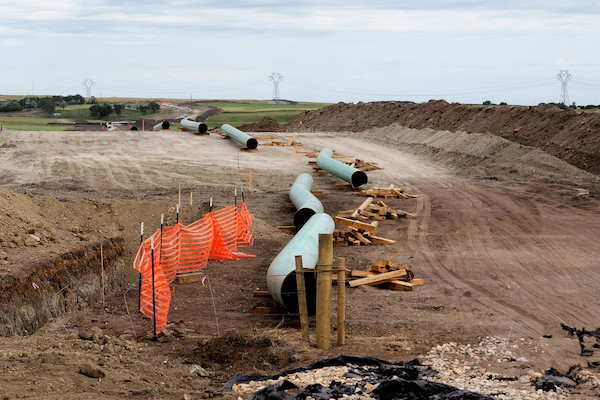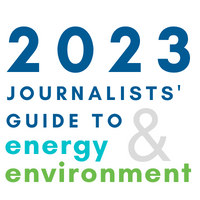SEJournal Online is the digital news magazine of the Society of Environmental Journalists. Learn more about SEJournal Online, including submission, subscription and advertising information.
 |
| The permitting process is an arena for serious environmental conflict. Two examples: The Keystone XL Pipeline expansion and the Dakota Access Pipeline (shown above, under construction in Campbell, South Dakota, in 2016). Photo: Lars Plougmann via Flickr Creative Commons (CC BY-SA 2.0). |
Issue Backgrounder: Whither the Permitting Reform Bill in 2023?
By Joseph A. Davis
Legislation on “permitting reform” will continue to occupy Congress in 2023 — but the term hides murky and conflicting agendas. Environmental journalists will need to scrutinize and translate what it means as a befuddled public also tries to figure it out (or ignores it altogether).
 |
Whatever the uncertainties, one certainty in the newly divided Congress is that the main driver of permitting reform, Joe Manchin (D-W.Va.), continues to chair the Senate Energy Committee that oversees the effort.
First a little background: Manchin’s permitting reform legislation was originally part of a deal on the Democrats’ $369 billion climate bill (aka the Inflation Reduction Act or IRA). To get Manchin’s vote on the climate measure, the White House and Democratic leaders in Congress agreed to a side deal giving Manchin a vote (and their support) on permitting.
As the last Congress waned, Manchin sought to attach his permitting bill to must-pass measures like the National Defense Authorization Act and the omnibus appropriations bill. That effort failed for lack of votes and Manchin’s permitting reform legislation ultimately died with a 47-47 vote in the Senate on December 15.
Still unclear is whether anything is left of Manchin’s side deal with Majority Leader Chuck Schumer (D-N.Y.) and President Biden.
Permitting an arena for conflict
Two key questions revolve around the issue: What exactly would the permitting reform bill do? And why would anyone support it?
But there’s no doubt that the permitting process is an arena for serious environmental conflict.
During the Obama administration, for example, the Keystone XL Pipeline expansion became a focus of nationwide demonstrations — as a surrogate for debate over fossil fuels, climate change and environmental justice. Because the pipeline crossed a border (it carried Canadian tar sands oil to the Midwest), approval by the White House was legally required.
Obama delayed it, Trump approved it, Biden revoked the permit and eventually the company trying to build it gave up.
It wasn’t the first time a company had run the gauntlet. Nor the last. The Dakota Access Pipeline was another case. While the Obama administration delayed it, the Trump administration immediately approved a permit. Protests on tribal land in 2016 galvanized Native American activism into a unified national movement. But the pipeline has been operating since June 2017.
Legal hoops abound for permitting
One thing we learned from these two struggles is how many legal hoops a project must jump through before it is built.
They exist at all levels of government (federal, state and local) and all kinds of government (for example, state public utility commissions). An alphabet soup of federal agencies may get involved, including but not limited to everything from the Federal Energy Regulatory Commission to the Pipeline and Hazardous Materials Safety Administration.
One of the key federal laws challenging infrastructure decisions is the 1970 National Environmental Policy Act, or NEPA, which requires environmental impact statements for major federal actions. NEPA requires public comment on these impact statements and requires agencies to address the comments.
All this takes time — which is why many industries dislike it. Donald Trump weakened NEPA (may require subscription) rules, but Biden largely restored them (may require subscription).
Permitting (much less its reform) is a
vast and thorny legal landscape that
Congress may not be able to fix
with a single legislative gesture.
The point of these examples is that permitting (much less its reform) is a vast and thorny legal landscape that Congress may not be able to fix with a single legislative gesture. To be at all effective, reform legislation will have to take into account many laws, a lot of politics and huge headaches. In a Congress so closely and so bitterly divided, it won’t be easy.
Some intrepid reporters are still doggedly asking: “What does Manchin really want?” The short answer may be the Mountain Valley Pipeline.
The MVP would carry fossil methane (natural gas) from West Virginia to southern Virginia. It is largely built but completely stalled. The bill language Manchin was pitching in 2022 explicitly cleared virtually all regulatory hurdles for the MVP — or would have if it had passed.
What’s in the bill? What bill?
For a long time, permitting reform was a vague and general outline that wasn’t written as legislation. Finally, in September, Manchin released something like a bill text. But he never introduced it.
At that time, Manchin had been involved in negotiations over the IRA climate bill, and even though the negotiations were private, all eyes were on Manchin because his uncertain vote was the key to getting it through the Senate. It was understood that Manchin had gotten a promise from Schumer and Biden to support his “bill.”
As chairman of the Senate Energy Committee, Manchin could have scheduled hearings and scrutinized the “bill.” He didn’t. He could have gotten his committee to mark it up and report it out of committee to the full Senate. He didn’t. Apparently, all that mattered was that he wanted it.
One thing the bill did have, though, was a provision essentially waiving further permitting approvals for the MVP.
Environmental benefits to permitting reform?
Some environmental groups acquiesce to (without overtly supporting) the Manchin side deal because it made possible the passage of the IRA climate bill. Along with the fossil-friendly provisions in that bill, were some of the most sweeping and powerful climate provisions Congress has ever enacted.
A few green advocates quietly admitted
that permitting reform could actually
help the environment if done right.
A few green advocates quietly admitted that permitting reform could actually help the environment if done right. Environmentalists and others worry that green energy like wind and solar currently can’t reach the interstate grid without more powerlines being built. Permitting fights have impeded this.
An example is the long and sprawling fight to build (may require subscription) a line carrying electricity from Hydro Quebec to the U.S. Northeast. Despite court cases and a ballot measure, that case is still unresolved.
The problem is that Manchin and environmentalists would likely settle these conflicts in different ways — another reason for careful, open, deliberate consideration of how to do permitting reform.
But in the end, even before the failed vote on the Senate floor to add the permitting reform bill as an amendment to the defense authorization act, it was clear that Manchin lacked the 60 votes he needed to succeed.
The proposal split both parties. Progressives didn’t like it because (among other things) it was bad for the climate. And it reinstated constraints on NEPA that the Biden administration had just recently de-Trumpified. Conservatives didn’t like it either, if only because it could drag down the defense bill. States and locals didn’t like it because it cut their permitting out of the process.
An alternative way to sell the permitting bill might have been to patiently and clearly explain to the public through hearings what it was and how it affected people’s interests.
So will Congress revive the permitting bill in 2023-2024? It’s a fair bet they may try — but a very long shot they will succeed. Most don’t see sufficient votes, especially now that Manchin’s own leverage is just slightly less critical in a 51-49 Senate.
Joseph A. Davis is a freelance writer/editor in Washington, D.C. who has been writing about the environment since 1976. He writes SEJournal Online's TipSheet, Reporter's Toolbox and Issue Backgrounder, and curates SEJ's weekday news headlines service EJToday and @EJTodayNews. Davis also directs SEJ's Freedom of Information Project and writes the WatchDog opinion column.
* From the weekly news magazine SEJournal Online, Vol. 8, No. 3. Content from each new issue of SEJournal Online is available to the public via the SEJournal Online main page. Subscribe to the e-newsletter here. And see past issues of the SEJournal archived here.

















